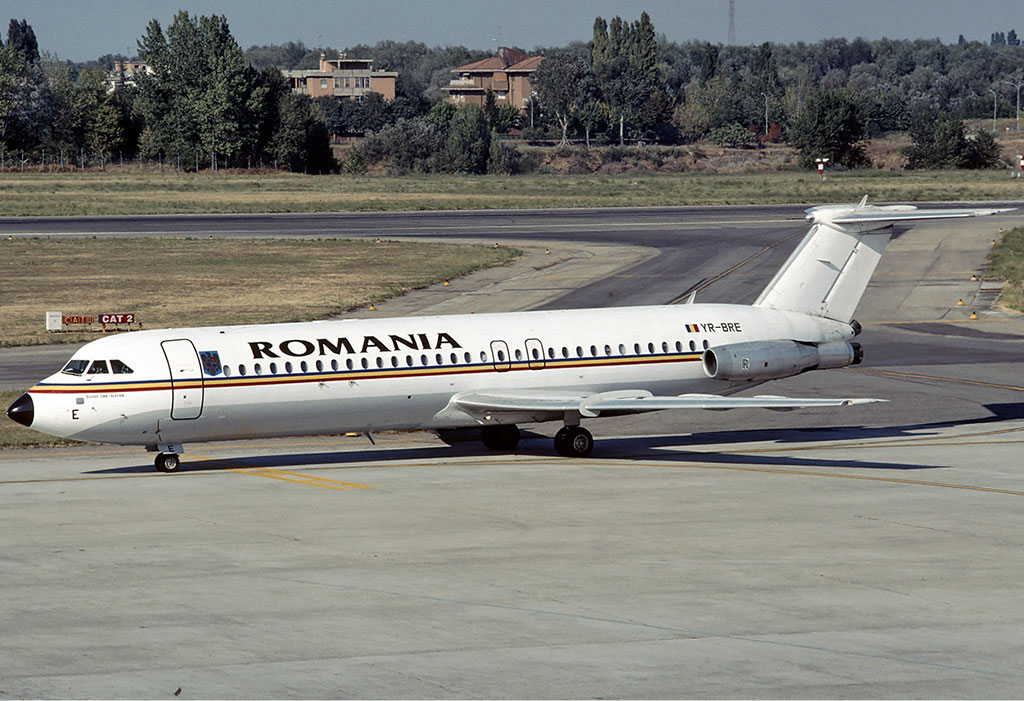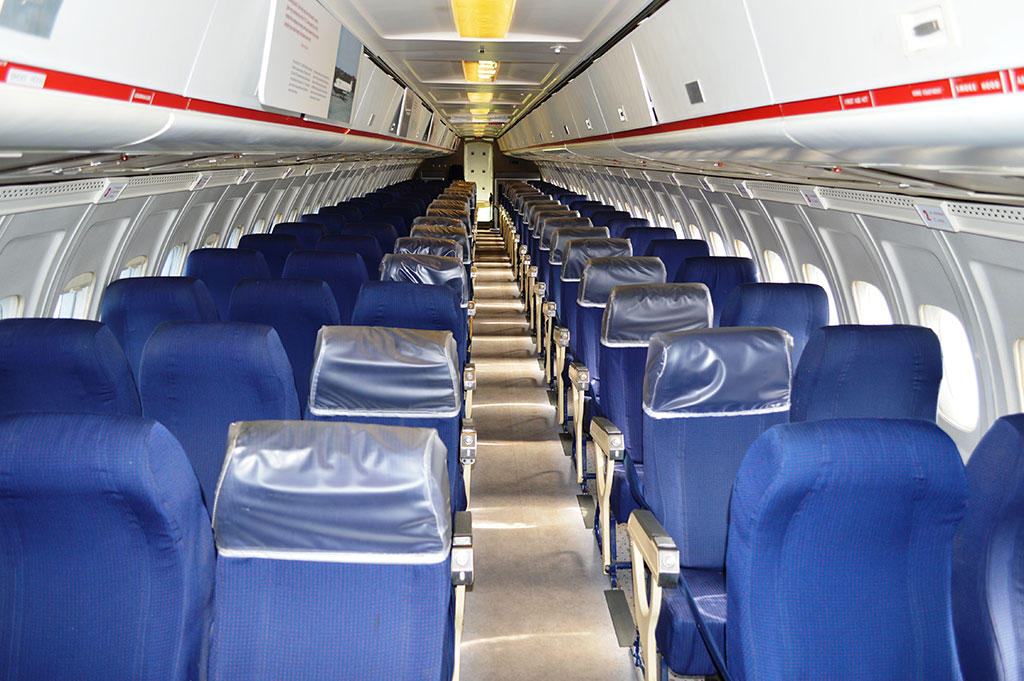The BAC One-Eleven was developed by the British Aircraft Corporation (BAC) as a jet successor to the highly successful Vickers Viscount turboprop. The original idea (H.107 concept) came from Hunting Aircraft but they became part of BAC before their concept had chance to come to fruition. BAC continued to develop the H.107 concept into an 80ft long aircraft with a T-tail and two rear engines, able to accommodate up to 59 passengers (the BAC 107). Airlines showed little enthusiasm for a 59 seat short-haul airliner but there was a lot of interest in an 80 seat version, especially in North America. BAC increased the BAC107 passenger capacity to eighty in a five-abreast seating arrangement. The project was renamed the BAC 1-11 and, in May 1961, the project was launched, including an initial order for ten aircraft from British United Airways.

Cockpit of BAC 1-11 510ED G-AVMO (ec BEA/BA) 1-11 510 at National Museum of Flight, East Fortune, Scotland. (Nigel Richardson)
The maiden flight of the One-Eleven prototype (G-ASHG) was on the 20 August 1963. However, by October 1963 it had been lost during a test flight investigating stalling characteristics, killing all seven crew members on board. The accident investigation revealed that the aircraft had entered a deep stall, which resulted from turbulent air from the stalled wing flowing over the elevator on top of the vertical stabiliser. This prevented the elevator from operating as an effective control surface to pitch the nose down and recover from the stall. In response, a number of modifications were made including powered elevators and the introduction of ‘stick shakers and pushers. The flight test programme recommenced early in 1964, involving the first six production aircraft and, despite several more significant incidents, the BAC 1-11 gained its certificate of airworthiness in April 1965.
The aircraft was very much designed for short/medium haul schedules and feeder flights involving short duration turnarounds. Features included built-in, hydraulically-operated airsteps on the forward passenger entrance (except on the BUA Series 200 and BEA Series 510 aircraft) and the ventral entry, four and five-abreast seating layouts in the passenger cabin, waist-high baggage holds with doors that swung down to the outside, an on-board auxiliary power unit (APU) so that ground power units were not required and an easily accessible single point for fuelling so that refuelling was relatively fast.
BAC 1-11 Variants

BAC 1-11 208AL EI-ANG of Aer Lingus at Birmingham Airport in 1985 (Rob Hodgkins, distributed under a CC BY-SA 2.0 Licence)
The first production model was the Series 200, with Rolls-Royce Spey Mk 506 engines. 58 aircraft were built, each able to seat up to 89 passengers. This variant initially operated with British United Airways (BUA) in April 1965, followed by Braniff International Airways later that month. Later operators included Mohawk Airlines, Aer Lingus, Aloha Airlines and Britsh Eagle.

BAC 1-11 304AX G-YMRU of Airways-Cymru (Clinton Groves, distributed under a GFDL 1.2 Licence)
Only nine Series 300 aircraft were built. These had uprated engines (Spey Mk 511) and an additional centre-section fuel tank to provide a longer range than the Series 200. Laker Airways and British Eagle were the only two airlines to acquire this variant.

BAC 1-11-401AK G-BBME of British Airways at Dusseldorf Airport (Peter Bakema, distributed under a GFDL 1.2 Licence)
The Series 400 aircraft was specially configured for United States carriers. It was essentially the same as the Series 300 aircraft but with American instrumentation and equipment, which resulted in an increase in the operating weight. The launch customer for the Series 400 was American Airlines, who introduced the type into service in March 1966. A number of other airlines ordered the Series 400, including Philippine Airlines, Channel Airways, Autair, Austral Lineas Aereas, Bavaria Fluggesellschaft and Tarom.

BAC 1-11 402AP EC-BQF of Trabajos Aereos y Enlaces (Christian Volpati, distributed under a GFDL 1.2 Licence)
As passenger numbers began to increase during the latter part of the 1960s, airlines required more seating in their aircraft. British European Airways (BEA) was also looking to replace their fleet of Vickers Viscounts. In response, BAC developed the Series 500, a stretched variant of the One-Eleven, which was13ft 6in longer (fuselage length of 107ft 0in) than the Series 200/300/400 aircraft all of which were 93ft 6in in length. The wingtips were also extended by 2ft 6in giving a 5ft increase in the wingspan. Fitted with more powerful Spey Mk 512 engines, the Series 500 aircraft could accommodate up to 119 passengers. The Series 500 was launched with an order from BEA in January 1967 for 18 aircraft, with an option for six additional aircraft.

BAC 1-11 518FG G-BDAT of Dan-Air at Birmingham Airport in January 1981 (G B_NZ, distributed under a CC BY-SA 2.0 Licence)
The BEA variant of the Series 500 included specific equipment changes to the avionics suite to produce commonality of the flight deck with that of the Hawker Siddeley Trident which was also operated by the airline at the time. This was designated Series 510.
The Series 500 was the most popular type of the One-Eleven. In addition to BEA, other operators included Austral, Bahamas Airways, BUA, Caledonian Airways, Court Line, Dan-Air, Tarom, Bavaria Flug., British Midland, Monarch Airlines, Philippine Airways and British Airways.

BAC 1-11 475EZ G-BLDH of McAlpine Aviation (Pedro Aragão, distributed under CC BY-SA 3.0 Licence)
Several other variants were built in the UK but only in small numbers. These were the Series 475, which combined the Series 400 fuselage with the wings and engines of the Series 500, together with undercarriage modifications for operating from hot and high altitude airfields with short and poorly prepared runways, and the Series 485, which was similar to the Series 475 and built solely for the Sultanate of Oman Air Force.

Rombac 1-11 561RC YR-BRE of Romania Airlines (Aldo Bidini, distributed under a GFDL 1.2 Licence)
In June 1979 British Aerospace, which had already formed from the merger of BAC with Hawker Siddeley, agreed a licensing arrangement for Romania to build the One-Eleven. This was called the ROMBAC project, and the initial plan was for the sale of three aircraft, to be built at Hurn in the UK, followed by the construction of 22 aircraft in Romania; although ultimately it was intended for up to 80 aircraft to be built. However, due to the unstable political environment in Romania and funding issues only nine aircraft were eventually completed and delivered to Tarom.
At the end of the One-Eleven’s production in 1989, a total of 244 aircraft had been built, 235 in the UK (222 built at Hurn, and 13 at Weybridge) and 9 in Romania.

Cabin interior of BAC 1-11 510ED G-AVMO at National Museum of Flight, East Fortune, Scotland. (Nigel Richardson)
BAC 1-11 Technical Specifications
| Ser. 200 | Ser. 300 | Ser. 400 | Ser. 475/485 | Ser. 500 | |
| Length | 93ft 6in | 93ft 6in | 93ft 6in | 93ft 6in | 107ft |
| Height | 24ft 6in | 24ft 6in | 24ft 6in | 24ft 6in | 24ft 6in |
| Wingspan | 88ft 6in | 88ft 6in | 88ft 6in | 93ft 6in | 93ft 6in |
| Empty weight | 46,405lb | 48,772lb | 50,822lb | 51,731lb | 54,582lb |
| Max. take-off weight | 79,000lb | 88,500lb | 88,500lb | 98,500,lb | 104,500lb |
| Engines | Spey 2
Mk. 506-14 |
Spey 25
Mk. 511-14 |
Spey 25
Mk. 511-14 |
Spey25
Mk. 512-14 |
Spey25
Mk. 512-14 |
| Max. number of passengers | 89 | 89 | 89 | 89 | 119 |
| Number built in UK | 58 | 9 | 70 | 12 | 86 |

BAC 1-11 510ED G-AVMO of British Airways at National Museum of Flight, East Fortune, Scotland. (Nigel Richardson)





1 comment
Loved the 1-11 and had 35 flights in them, series 200, 400 and 500 and many jump seat trips as a bonus.
Glad there are quite a few preserved on display.